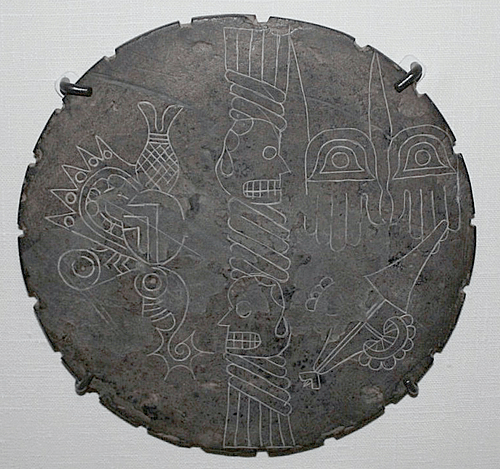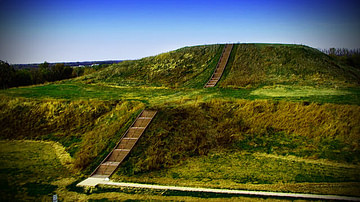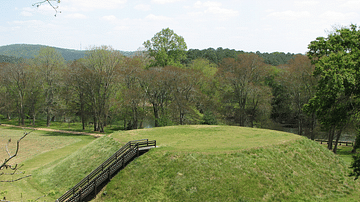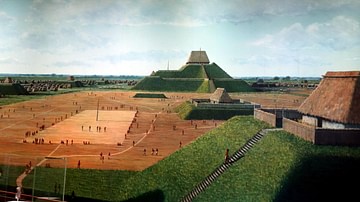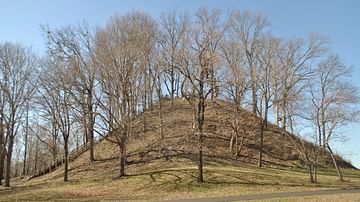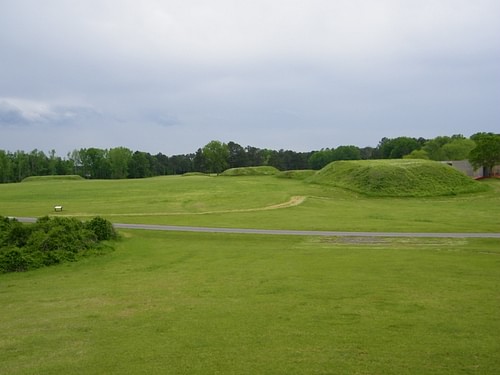
Moundville is an archaeological site and park in Hale County, Alabama, USA on the Black Warrior River enclosing a Native American site dated to c. 1100 - c. 1450 CE. The earthen mounds which give the site its modern name were built by an unknown tribe associated with the Mississippian Culture. The ancient name of the city is unknown.
Moundville is the second largest “mound builder” site preserved in the USA after Cahokia in Illinois and is often compared with it but the two were significantly different in many ways. One of the major differences between them is that the elite of the Moundville people lived and buried their dead on the mounds they created as a matter of course while, at Cahokia, only some mounds were used as graves or to support residences. Both cities had a large mound (Mound A at Moundville and Monks Mound at Cahokia) dedicated to religious/political purposes and the two cities may have traded with each other but are thought to have been founded and developed by two different cultures. Other differences include the types of crafts produced and how Moundville, unlike Cahokia, was designed to specifically reflect the highly stratified social hierarchy of the community.
The site first came to public attention in the late 19th century and excavations were begun by the independent, amateur archaeologist C.B. Moore (l. 1852-1936) of Philadelphia in 1905-1906. Moore’s publications on his excavations and discussions of the many artifacts he had removed prompted the Alabama Legislature to pass laws prohibiting anyone else from taking artifacts out of the state. Moore’s work established Moundville as a site worthy of attention, however, and professional excavations began in 1929 by Walter B. Jones (l. 1895-1977) of the Alabama Museum of Natural History and the archaeologist David L. DeJarnette (1907-1991). Archaeological work at the site has continued from that time to the present, bringing to light more of the history of the once vast city.
Mississippian Culture & Mound Building
The term Mississippian Culture refers to a Native American population inhabiting, roughly, the area between present-day northeastern USA down to Louisiana with a concentration in the Mississippi River Valley, Ohio River Valley, and Tennessee River Valley. Although they created interesting and unique crafts and ceramics, they are primarily known for raising their enormous earthen mounds. Some of these mounds were used for purely practical purposes such as supporting the residences of the upper class, while others seem to have been built to elevate the priests or priest-king above the populace and closer to the sun which was worshipped as a god.

The two best-known communities of this period are the Adena Culture (c. 800 BCE-1 CE) and the Hopewell Culture (c. 100 BCE-500 CE) who continued a tradition of mound building dating back over 5,000 years. The Hopewell are thought to have succeeded the Adena, though this claim has been challenged, and both lived in the areas of modern-day Virginia, West Virginia, Ohio, Pennsylvania, Kentucky, and Indiana. The names of both are modern-day designations; no one knows how the people referred to themselves.
The Adena built cone-shaped mounds which differed from the Hopewell’s in that the latter created intricate mounds often in the shapes of animals and the two varied in other ways, but both engaged in long-distance trade. Scholar Yvonne Wakim Dennis writes:
Adena copper, stone, and cloth items were circulated as far as northern New Jersey, along with the Algonquian language. Variants of Algonquian are still spoken by the more egalitarian communities descended from the Adenans, who had settled as far as western New York and Pennsylvania by 200 CE. In Ohio, Hopewell artifacts have been dated to 400 BCE. Yellow clay Hopewell earthworks were built to last, and many still remain, in the shapes of birds, snakes, and geometric patterns that are so large, they are best viewed from the air. (134)
Both cultures were highly sophisticated and developed agricultural and technological innovations which were passed down and further developed by later cultures such as those who built Moundville and Cahokia. Dennis comments:
Far from being the passive children of nature depicted in colonial reports both romantic and damning, Indians practiced calculated and extensive resource management. Nor were the people of the Midwest simple nomads, but urbanized engineers, long-distance traders, and large-scale farmers. (135)
The resource management Dennis references was directly inspired by the peoples’ religion which was a form of animism, the belief that all things are imbued with spirits and everything is interconnected in a web of reciprocity. In the modern day, Native American beliefs have often been interpreted as based on a recognition of the importance of ecology but, as scholar Alan Taylor points out, this respect was born of recognition of the unseen forces which inhabited the land, trees, animals, and everything else:
Indian animism should not be romantically distorted into a New Age creed of stable harmony. In fact, the natives regarded the spiritual world as volatile and full of tension, danger, and uncertainty. To survive and prosper, people had to live warily and opportunistically. Engaged in an always difficult balancing act, humans had to discern when they could trick and manipulate the spirits and when they should soothe and mollify them…The logic of restraint was animist rather than ecological – but that restraint tended to preserve a nature that sustained most native communities over many generations. (19)
This kind of restraint, respect for nature, and the need to placate and please the gods and spirits are all thought to have encouraged the development of communities such as Moundville. The varied energies of the surrounding area were centered, and perhaps thought to be controlled, by the mounds which elevated the nobles and priestly class closer to the realm of the sun and the spirits of the air while drawing on the chthonic forces of the earth.
Moundville & Social Stratification
Although influenced by the Adena and Hopewell cultures, the people of Moundville are thought to have been distinctly different from them. This belief is supported by Moundville’s cultivation of corn, unknown to the earlier cultures, as well as differences in their ceramics, other crafts, and their treatment of dogs. In the 1890’s, C. B. Moore excavated a number of different sites before arriving at Moundville and discovered the earlier cultures had a higher regard for dogs than the people of the later city. Scholar Marion Schwartz comments on the status of dogs in the earlier cultures:
Dogs, buried separately with no discernable ritual intent, may have enjoyed a particularly high status…This status resulted in the considerable human effort of burying dogs at death. Rather than being seen as necessary to conducting humans safely to the next world, dogs were allowed to live out their lives and, on dying, were buried “like people”. They were on their way, perhaps, to the same after-death destination as humans. (108-109)
At Moundville, no dog graves were discovered but dog bones were found in middens (garbage pits) suggesting that dogs were a food source for the people whereas, to the Adena and Hopewell, they had been animals deserving of respect in their own right. Moundville differed from the earlier cultures in other ways, as well as from the people of Cahokia, but especially so in their deliberate construction of mounds to support residences of the elite and clarify social stratification through architecture.
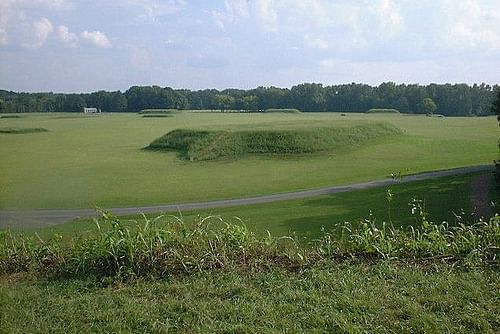
Moundville was a carefully designed and executed urban center in which the upper-class lived in wood homes on the flat tops of the mounds overlooking a central plaza while the lower classes lived in thatch huts below. The residential mounds alternated with burial mounds although the deceased of the upper-class were also buried on their home-mound (which is how archaeologists have determined the mounds’ purposes, through grave goods and types of burial). In the center of the plaza, rose a large mound now known as Mound A which served as the site for religious rituals and the whole city was surrounded by a wooden palisade on three sides with the fourth side open to the river.
Early excavators at the site believed the wall was built for defensive purposes and this is probably correct. A similar palisade was built at Cahokia seemingly to prevent flooding and it has been suggested that the Moundville wall served the same purpose. This would not make sense, however, in that one whole side of the city was left open to the river. Mound A was built with a direct view of the river from its top, suggesting a connection between all four elements of earth, air, fire, and water in religious rituals. The homes of the upper-class were then built on the tops of the other mounds facing Mound A.
The three social classes at Moundville were:
- Chiefs and the Upper-Class
- Workers, craftspeople, and farmers
- Lower-class laborers
The middle and lower-class were buried in simple graves near their homes around the plaza with grave goods such as tools and rough ceramics. The upper and ruling class deceased were interred on the mounds with valuables such as shells, smoothed stones, copper implements, high-grade ceramics, and copper axes. These axes are thought to have been symbols of authority, rank, and political power used in rituals as they appear unused and, made of copper, are too soft to have been used effectively in warfare or lumber-harvesting. The grave goods of the elite came from long-distance trade with other communities, but some of the copper artifacts were most likely made on site.
Religious & Cultural Center
The plaza was artificially created, filled, and leveled before the construction of the mounds which were built in stages and range in height from under 10 feet to over 50. The small ponds and lakes one finds at the modern-day site are the pits the natives harvested soil from to build the mounds which drew people of neighboring communities to settle there as laborers, adding to the population of over 1,000 (which eventually may have reached over 3,000). Moundville’s extensive corn crop created a surplus food supply which was used not only in trade but to pay laborer’s wages.
In time, more people seem to have come to the city for spiritual purposes as it became known as a religious and cultural center. This is evidenced by finds suggesting a population increase and artifacts, such as stone pipes, associated with religious ritual. The Adena, Hopewell, and later cultures such as Moundville and Cahokia cultivated tobacco, specifically Nicotiana rustica, which was smoked or chewed to elevate the user’s mind and connect one with the spirit world. Discovery of a number of pipes, as well as tobacco spores in middens, suggest an increase in religious activity in the community. Tobacco was used to induce visions and dreams in which gods and spirits answered peoples’ questions or otherwise provided direction in life. Taylor comments:
Dreams and visions enabled native people to communicate with the spirits to enlist their aid in hunting, gathering, cultivating, and war. Natives regarded the nocturnal dreamworld as fundamentally more real and powerful than their waking hours. They also provoked visions by prolonged fasting and isolation (sometimes aided by ingesting psychotropic plants). The most adept dreamers and visionaries became shamans, who acted as intermediaries between people and the other-than-human beings. Shamans conducted rituals to promote the hunt, secure the crops, and protect their warriors…But even the most skilled shaman often failed in the complex contests to influence, lull, and propitiate spirit beings. (19)
It is possible that this is what happened at Moundville to cause its abandonment in c. 1450 CE. Unlike Cahokia, which shows signs of natural and human-made problems contributing to its decline, Moundville seems to have been thriving up until c. 1300 when the mounds begin going unused and rituals on Mound A between c. 1300-1450 slow and then cease. No reason for the abandonment of Moundville has been universally agreed upon and it is possible that it was due to a perceived failure of the priestly class to propitiate the spirits and provide good harvests, health, and prosperity. It is also possible that, as at Cahokia, overpopulation resulted in the depletion of resources.
Either way, by c. 1450 CE, Moundville was deserted, and the people moved elsewhere, including present-day St. Louis, Missouri, where they built other mounds. Sugarloaf Mound is the last surviving in St. Louis as the others, notably the majestic Big Mound, were destroyed by city planners in the 19th century to make way for commercial and residential expansion.
Discovery & Excavation
Moundville was first mapped in 1869, the same year Big Mound was destroyed in St. Louis, by Nathaniel T. Lupton, then-president of the University of Alabama, but no efforts were made to excavate at that time. Excavation was begun in 1905 through 1906 by C. B. Moore, a Harvard-educated amateur archaeologist who had become wealthy from his family’s paper business and devoted himself to archaeology, traveling around in his steamboat, The Gopher, engaging in personally funded excavations. Moore was particularly interested in the “mound builders” and arrived at Moundville in 1905, dug into a number of mounds, and extracted ancient artifacts which he sent back to his home city of Philadelphia while also featuring them in his published picture books and journals which became quite popular reading.
Moore’s books were eventually noticed by the government of the State of Alabama which then passed laws to protect the state’s archaeological sites from looting. Moore’s efforts drew attention to the site, however, inspiring a grassroots movement to save it led by Walter B. Jones. Jones mortgaged his own home to buy the site and professional excavations were begun by him and David L. DeJarnette in 1929.
Mound State Park was established in 1933 and, at that time, the two men enlisted the aid of the Civilian Conservations Corps, (a program established by then US President Franklin D. Roosevelt to provide jobs during the Great Depression), to restore the mounds, cultivate the grounds, build roads and pathways, and construct the building which would serve as the museum of the site (named the Jones Archaeological Museum in Jones’ honor). DeJarnette took over as the park’s director in the 1950’s and served as the site’s leading archaeologist for the next 20 years. His efforts have largely directed those which have been ongoing since.
In 1964, Moundville Archaeological Park was declared a National Historic Monument and funding from various sources allowed for further work at the site. Even so, only about 15% of Moundville has been fully excavated from 1929 to 2021. Renovations to the museum and grounds in 2010 improved accessibility and the showcasing of its permanent exhibits which, in 2019, were enlarged by a renewable loan from the Smithsonian Institution of artifacts excavated by Moore in 1905-1906 that he later donated to them. Present restrictions due to the Covid-19 virus dictate visitation to the site which, annually, welcomes visitors from around the world who come to learn about the great mound builders but, once these are lifted, more guests are expected to continue the tradition of meeting the past through the mounds and artifacts of the ancient city.
